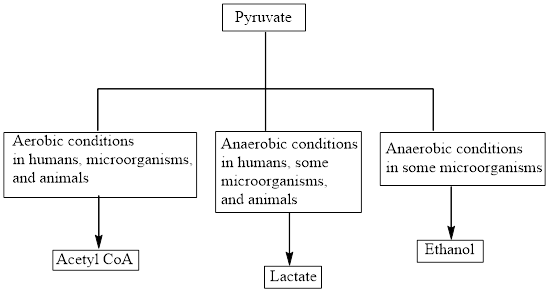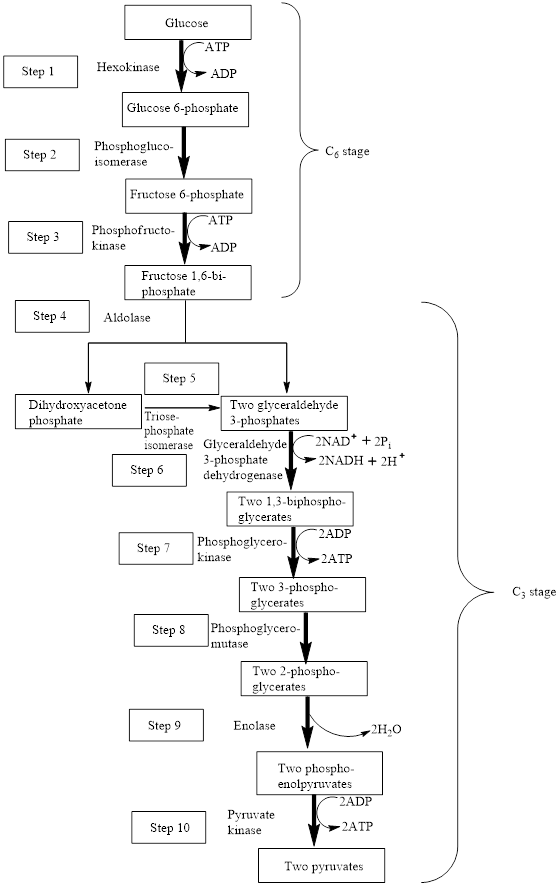
Concept explainers
(a)
Interpretation: To indicate whether
Concept introduction: In the glycolysis
Pyruvate is the end product in the glycolysis. The production of the fate of pyruvate varies with the nature of the organism and the cellular conditions. The three common fates of pyruvate are as follows:

(a)
Answer to Problem 24.47EP
Carbon dioxide
Explanation of Solution
Reason for correct option:
Under aerobic conditions, pyruvate is converted to

The overall reaction equation for the conversion of pyruvate to
The process of ethanol fermentation takes place in two steps. In step 1, the pyruvate molecule is converted to acetaldehyde by pyruvate decarboxylase enzymes. Carbon dioxide molecule is produced in this step. The chemical reaction is as follows:

In step 2, acetaldehyde is reduced to ethanol by alcohol dehydrogenase enzymes. The chemical reaction is as follows:

The overall ethanol fermentation equation is as follows:
Therefore,
Reason for incorrect option:
The net overall equation for the glycolysis process is as follows:
The overall reaction equation for lactate fermentation is as follows:
(b)
Interpretation: To indicate whether
Concept introduction: In the glycolysis metabolic pathway, a glucose molecule breaks down into two pyruvate molecules. Two ATP molecules and NADH reduced coenzymes are produced in the glycolysis pathway.
Pyruvate is the end product in the glycolysis. The production of the fate of pyruvate varies with the nature of the organism and the cellular conditions. The three common fates of pyruvate are as follows:

(b)
Answer to Problem 24.47EP
Pyruvate is oxidized to
Explanation of Solution
Reason for correct option:
Under aerobic conditions, pyruvate is converted to
Reason for incorrect option:
The net overall equation for the glycolysis process is as follows:
The overall ethanol fermentation equation is as follows:
The overall reaction equation for lactate fermentation is as follows:
(c)
Interpretation: To indicate whether ATP is associated with (1) glycolysis, (2) pyruvate oxidation, (3) lactate fermentation, or (4) ethanol fermentation.
Concept introduction: In the glycolysis metabolic pathway, a glucose molecule breaks down into two pyruvate molecules. Two ATP molecules and NADH reduced coenzymes are produced in the glycolysis pathway.
Pyruvate is the end product in the glycolysis. The production of the fate of pyruvate varies with the nature of the organism and the cellular conditions. The three common fates of pyruvate are as follows:

(c)
Answer to Problem 24.47EP
A net gain of two ATP molecules occurs when one glucose molecule is converted to two pyruvate molecules through the glycolysis pathway. Therefore, ATP is associated with (1) glycolysis.
Explanation of Solution
Reason for correct choice:
The block diagram to represent an overview of glycolysis is as follows:

The net overall equation for the glycolysis process is as follows:
In step 1 and step 3, one ATP molecule is consumed in each step. In step 7 and step 10, two ATP molecules are produced in each step. Hence, in the glycolysis pathway, two ATP molecules are consumed and four ATP molecules are produced. Therefore, a net gain of two molecules of ATP occurs in the glycolysis pathway.
Reason for incorrect choice:
The overall reaction equation for the oxidation of pyruvate is as follows:
The overall ethanol fermentation equation is as follows:
The overall reaction equation for lactate fermentation is as follows:
ATP is neither consumed nor formed in the pyruvate oxidation, ethanol fermentation, and lactate fermentation. Therefore, ATP is not associated with pyruvate oxidation, ethanol fermentation, and lactate fermentation.
(d)
Interpretation: To indicate whether NADH is associated with (1) glycolysis, (2) pyruvate oxidation, (3) lactate fermentation, or (4) ethanol fermentation.
Concept introduction: In the glycolysis metabolic pathway, a glucose molecule breaks down into two pyruvate molecules. Two ATP molecules and NADH reduced coenzymes are produced in the glycolysis pathway.
Pyruvate is the end product in the glycolysis. The production of the fate of pyruvate varies with the nature of the organism and the cellular conditions. The three common fates of pyruvate are as follows:

(d)
Answer to Problem 24.47EP
In the glycolysis process and oxidation of pyruvate, NADH is formed as a product while it is encountered as a reactant in lactate fermentation and ethanol fermentation. Therefore, NADH is associated with (1) glycolysis, (2) pyruvate oxidation, (3) lactate fermentation, and (4) ethanol fermentation.
Explanation of Solution
The net overall equation for the glycolysis process is as follows:
The overall reaction equation for the conversion of pyruvate to
The overall ethanol fermentation equation is as follows:
In the absence of oxygen, pyruvate is converted to lactate by lactate dehydrogenase enzymes in the human body. The overall reaction equation for the conversion of pyruvate to lactate is as follows:
NADH is produced in the glycolysis process and pyruvate oxidation while it is consumed in ethanol fermentation and lactate fermentation. Therefore, NADH is associated with all four processes.
Want to see more full solutions like this?
Chapter 24 Solutions
EBK GENERAL, ORGANIC, AND BIOLOGICAL CH
- Ch.21 What causes patients infected with the yellow fever virus to turn yellow (jaundice)? A. low blood pressure and anemia B. excess leukocytes C. alteration of skin pigments D. liver damage in final stage of disease — What is the advantage for malarial parasites to grow and replicate in red blood cells? A. able to spread quickly B. able to avoid immune detection C. low oxygen environment for growth D. cooler area of the body for growth — Which microbe does not live part of its lifecycle outside humans? A. Toxoplasma gondii B. Cytomegalovirus C. Francisella tularensis D. Plasmodium falciparum — explain your answer thoroughlyarrow_forwardCh.22 Streptococcus pneumoniae has a capsule to protect it from killing by alveolar macrophages, which kill bacteria by… A. cytokines B. antibodies C. complement D. phagocytosis — What fact about the influenza virus allows the dramatic antigenic shift that generates novel strains? A. very large size B. enveloped C. segmented genome D. over 100 genes — explain your answer thoroughlyarrow_forwardWhat is this?arrow_forward
- Molecular Biology A-C components of the question are corresponding to attached image labeled 1. D component of the question is corresponding to attached image labeled 2. For a eukaryotic mRNA, the sequences is as follows where AUGrepresents the start codon, the yellow is the Kozak sequence and (XXX) just represents any codonfor an amino acid (no stop codons here). G-cap and polyA tail are not shown A. How long is the peptide produced?B. What is the function (a sentence) of the UAA highlighted in blue?C. If the sequence highlighted in blue were changed from UAA to UAG, how would that affecttranslation? D. (1) The sequence highlighted in yellow above is moved to a new position indicated below. Howwould that affect translation? (2) How long would be the protein produced from this new mRNA? Thank youarrow_forwardMolecular Biology Question Explain why the cell doesn’t need 61 tRNAs (one for each codon). Please help. Thank youarrow_forwardMolecular Biology You discover a disease causing mutation (indicated by the arrow) that alters splicing of its mRNA. This mutation (a base substitution in the splicing sequence) eliminates a 3’ splice site resulting in the inclusion of the second intron (I2) in the final mRNA. We are going to pretend that this intron is short having only 15 nucleotides (most introns are much longer so this is just to make things simple) with the following sequence shown below in bold. The ( ) indicate the reading frames in the exons; the included intron 2 sequences are in bold. A. Would you expected this change to be harmful? ExplainB. If you were to do gene therapy to fix this problem, briefly explain what type of gene therapy youwould use to correct this. Please help. Thank youarrow_forward
- Molecular Biology Question Please help. Thank you Explain what is meant by the term “defective virus.” Explain how a defective virus is able to replicate.arrow_forwardMolecular Biology Explain why changing the codon GGG to GGA should not be harmful. Please help . Thank youarrow_forwardStage Percent Time in Hours Interphase .60 14.4 Prophase .20 4.8 Metaphase .10 2.4 Anaphase .06 1.44 Telophase .03 .72 Cytukinesis .01 .24 Can you summarize the results in the chart and explain which phases are faster and why the slower ones are slow?arrow_forward
- Can you circle a cell in the different stages of mitosis? 1.prophase 2.metaphase 3.anaphase 4.telophase 5.cytokinesisarrow_forwardWhich microbe does not live part of its lifecycle outside humans? A. Toxoplasma gondii B. Cytomegalovirus C. Francisella tularensis D. Plasmodium falciparum explain your answer thoroughly.arrow_forwardSelect all of the following that the ablation (knockout) or ectopoic expression (gain of function) of Hox can contribute to. Another set of wings in the fruit fly, duplication of fingernails, ectopic ears in mice, excess feathers in duck/quail chimeras, and homeosis of segment 2 to jaw in Hox2a mutantsarrow_forward
 Concepts of BiologyBiologyISBN:9781938168116Author:Samantha Fowler, Rebecca Roush, James WisePublisher:OpenStax College
Concepts of BiologyBiologyISBN:9781938168116Author:Samantha Fowler, Rebecca Roush, James WisePublisher:OpenStax College BiochemistryBiochemistryISBN:9781305577206Author:Reginald H. Garrett, Charles M. GrishamPublisher:Cengage Learning
BiochemistryBiochemistryISBN:9781305577206Author:Reginald H. Garrett, Charles M. GrishamPublisher:Cengage Learning
 Biology: The Dynamic Science (MindTap Course List)BiologyISBN:9781305389892Author:Peter J. Russell, Paul E. Hertz, Beverly McMillanPublisher:Cengage Learning
Biology: The Dynamic Science (MindTap Course List)BiologyISBN:9781305389892Author:Peter J. Russell, Paul E. Hertz, Beverly McMillanPublisher:Cengage Learning Biology (MindTap Course List)BiologyISBN:9781337392938Author:Eldra Solomon, Charles Martin, Diana W. Martin, Linda R. BergPublisher:Cengage Learning
Biology (MindTap Course List)BiologyISBN:9781337392938Author:Eldra Solomon, Charles Martin, Diana W. Martin, Linda R. BergPublisher:Cengage Learning





